
This Lineage
Pas de Deux Dancers in Scènes de Ballet, Past and Future
, May 7, 2024
Following the premiere of his first work for the Company, 1997’s Slavonic Dances, choreographer and then-Soloist Christopher Wheeldon created two works for the students at the School of American Ballet. The first, Soirée Musicale, was choreographed for 17 advanced students dancing in SAB’s 1998 Workshop Performances, which provide an annual opportunity for the public to see these young artists’ efforts on the stage of Lincoln Center’s Peter Jay Sharp Theater. The second ballet similarly celebrated 64 of the School’s dancers—enough to fill New York City Ballet’s stage—while simultaneously reflecting both the historical foundations of the vocabulary these students were learning, and their development through the training they were receiving. Premiering as part of the NYCB season in 1999, Scènes de Ballet is set in a makeshift studio bisected by a typical barre. The ballet begins with two young dancers who mirror one another from either side of the barre; each successive section of the ballet features dancers of increasing age and experience, culminating in a pas de deux for a couple of advance students.
The day after the premiere of Scènes, dance critic Anna Kisselgoff wrote in The New York Times: “There is also a sensuous and superbly configured adagio fabulously performed by a senior couple, Faye Arthurs and Craig Hall.” Arthurs and Hall would both go on to dance with NYCB less than a year later, and Hall is now a repertory director for the Company. We spoke with them about their memories of creating this lasting, generationally significant ballet, and with the four current students who will be interpreting their roles in upcoming performances.
Interviews edited for length and clarity.
CRAIG HALL: I think I was 18 turning 19, and it was my last year in the School. We would come over to the Theater just about every night when the Company was in season to see performances, so I knew of Christopher [Wheeldon]. I was in awe of him as a dancer—he had an amazing facility. I remember his beautiful feet, his clean lines, and that he had a very bubbly personality onstage. I think that year he debuted in Jerome Robbins’ Dances at a Gathering in the Brick pas, which is being danced now by Andres Zuniga. I saw Andres debut with Megan Fairchild the other day, so to see that and remember watching Chris the first time, when he was a young dancer as well as a budding choreographer, it's like a full-circle moment.
FAYE ARTHURS: I was 16 or 17; it was my second full year at SAB, so I was in 11th grade. During my first year, Chris was making Soirée Musicale [on SAB students for Workshop Performances] and it seemed like, “Oh my gosh, to be chosen to work with Chris Wheeldon….” That experience of watching someone be the art and then come and work with us felt like such a connection to the real world of ballet. It was so thrilling. My second year, when I was called to learn the pas de deux [of Scènes de Ballet], it was a little bit of an audition process. I was partnered with Craig and there were a few other couples, and I remember thinking, “Wow, even just to be here and in the Wheeldon room….” It was such a big deal.
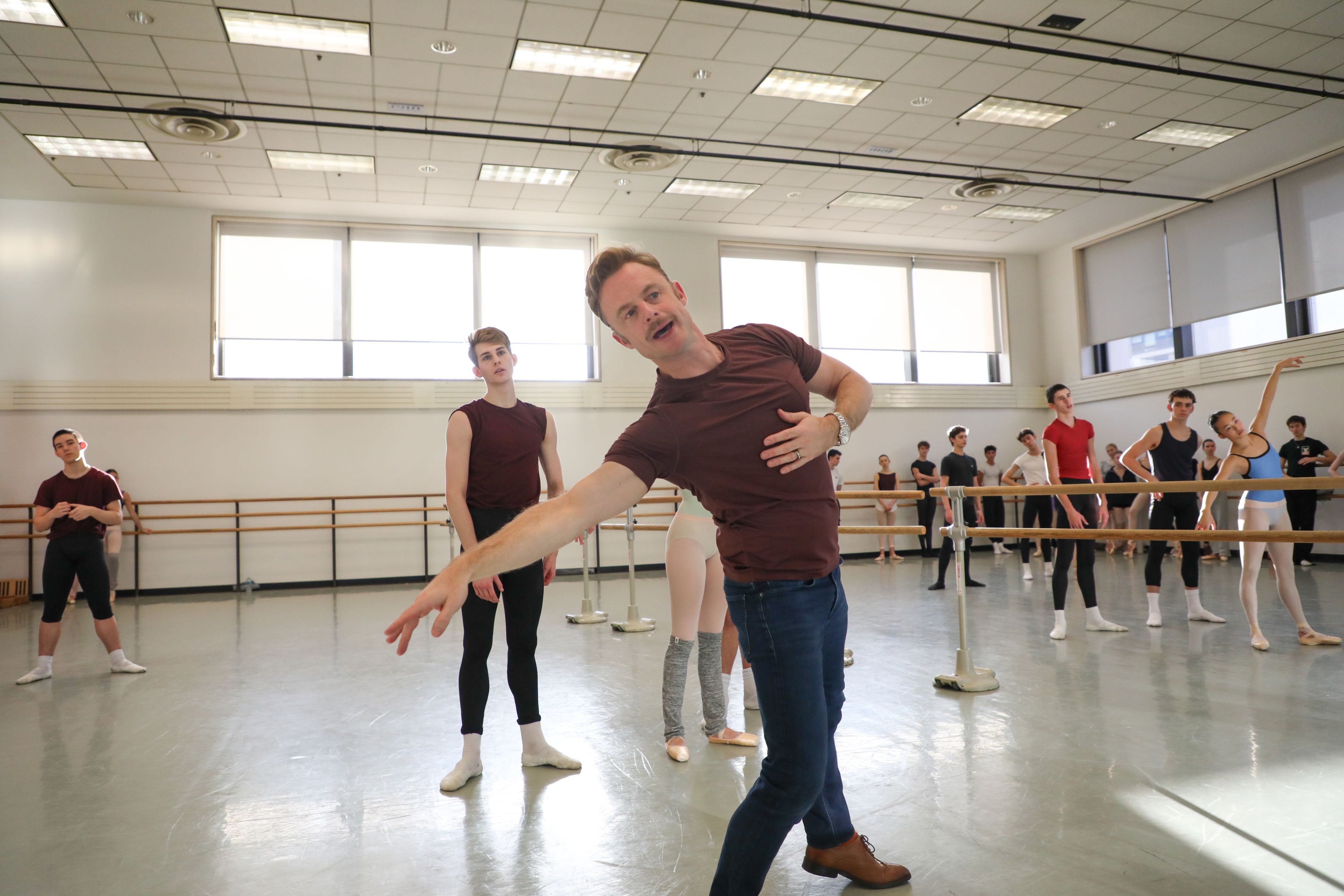 CRAIG: I remember he came into the studio with a very clear idea of a mirrored image in a studio setting, and the progression through the levels, culminating with this pas de deux with the senior students. He was very carefree in the studio, and always came prepared and precise with the counts and with the shapes that he wanted to make. As kids, we were definitely the "clay" and a little bit intimidated, so I don't think that we were in a place to suggest, “I think this step feels better this way.” It was, “This is what the choreographer wants, and this is what we're giving him.” He was very open and demanding, but in the most nurturing way—"I know we can get this out of you, we can push a little bit further, let's make this a little bit sharper.”
CRAIG: I remember he came into the studio with a very clear idea of a mirrored image in a studio setting, and the progression through the levels, culminating with this pas de deux with the senior students. He was very carefree in the studio, and always came prepared and precise with the counts and with the shapes that he wanted to make. As kids, we were definitely the "clay" and a little bit intimidated, so I don't think that we were in a place to suggest, “I think this step feels better this way.” It was, “This is what the choreographer wants, and this is what we're giving him.” He was very open and demanding, but in the most nurturing way—"I know we can get this out of you, we can push a little bit further, let's make this a little bit sharper.”
FAYE: He treated us like we were on his level, and like we were real adults, which was kind of amazing. It felt like experimentation and play—it was challenging, but also playful. Chris had these creative bursts, and then he would go back and do cleaning mode, and that's when his proper Britishness would come through—”Oh, your little toe, and your pinkie….” But it was really fun, because both of those aspects are enjoyable. That's what the student process is about.
CRAIG: There was always laughter in the studio. Even though we were making serious, good work, it didn't seem like it wasn't fun or like something that we didn't want to tackle every time we came into a rehearsal with him. Olga Kostritzky, who was also on the faculty at the School, rehearsed us when Chris couldn’t. She would rehearse Faye and I for hours, particularly about the first step, before we even stepped out on the stage—that we were entering this room, coming from another world. I didn't understand that at the time. In so much choreography, especially in Robbins and even Justin Peck, you aren’t just alive as soon as you take that step onto the stage; your character has a life before you enter this room. And we investigated that.
She told me, “You will never be a jester or a jumpy type of dancer, your gift is being a partner. You have such elegance in that role, and if you can understand that now, as a teenager, that will take you very far.” At first, I was defiant, I did not want to hear that; I wanted to do all of the jumpy roles. But I realized shortly after that that wasn't my gift. Mine was to connect with a ballerina or another dancer onstage, and to have a conversation with them, a relationship, and to investigate that relationship for the audience. I felt so comfortable as a partner. To this day, whenever I'm in the studio coaching the dancers, I have to demonstrate the choreography, I have to feel it; then I tell them what I feel, and hopefully that translates for them. [Former Principal Dancer] Jock Soto was my idol when it came to partnering; he spoke to the ballerina without using words, but through a touch, through a feeling, through a transfer of energy. And I understood that so early on because of Scènes. We are all talented in a lot of ways in the Company, but dancers tend to go down certain routes—if they are a partner or if they're a solo dancer, if they're a technician or a more contemporary mover. Mine was definitely partnering. After Jock retired, Chris chose me again, to start dancing with Wendy. We had a pretty great partnership until she retired. I think that through Scènes de Ballet, I was able to discover my gift as a partner, so I always think of this ballet as the launchpad to my career.
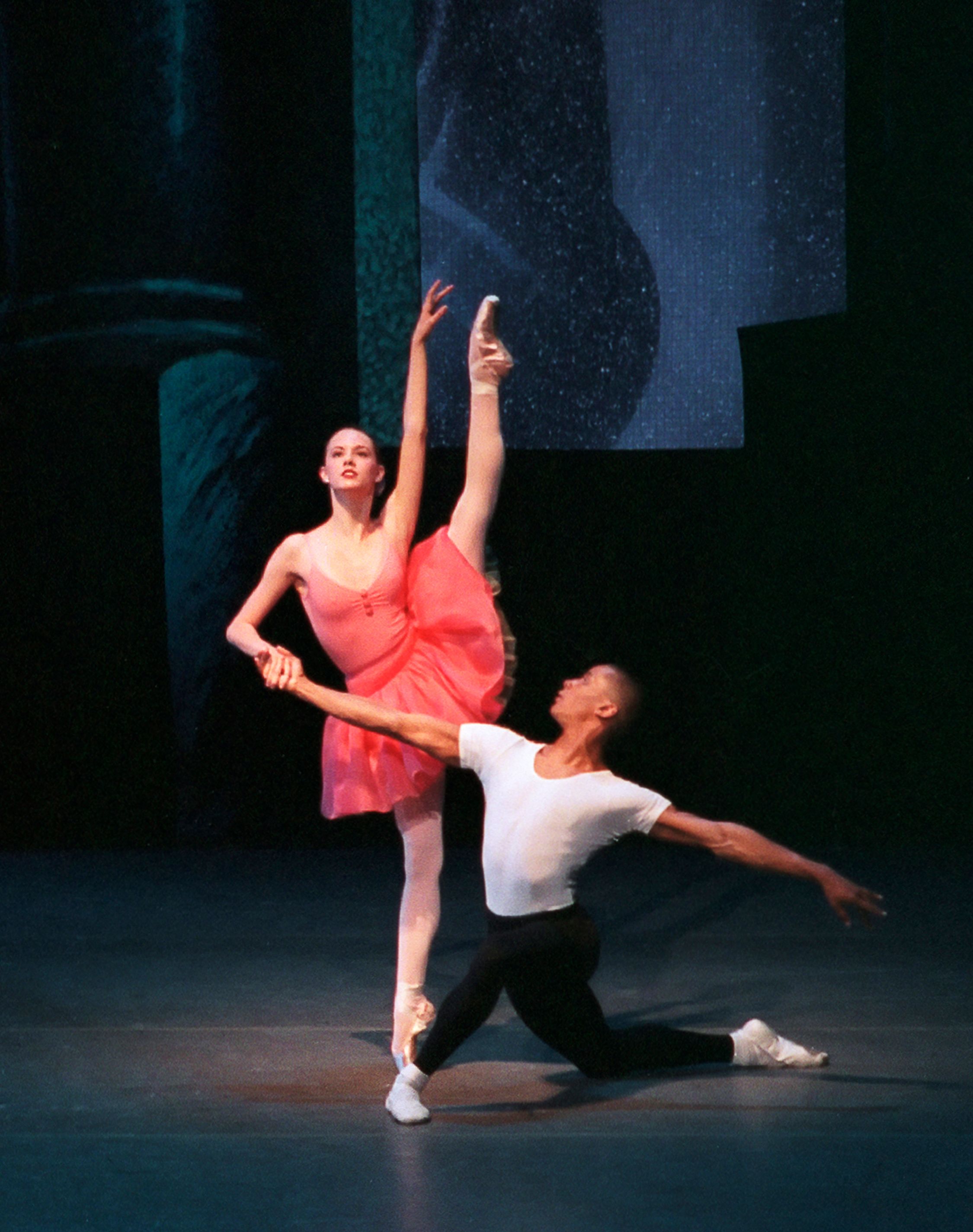 FAYE: I just watched it for the first time in many years. I was running a Ballet Connoisseurship lecture for SAB, talking a little bit about the history of Workshop Performances. They wanted to show Scènes because it's coming back, and they were going through highlights, and I had not seen the pas de deux in decades. It was so surprising because it's really long and hard. I had forgotten how significant a set piece it was. It's almost a lullaby; you’re in a dreamstate, rocking back and forth, up and down. Everything gets dark. Craig was such an amazing partner, so it was floaty, dreamy, and wonderful for me. It was a special moment. I remember we would hug each other in the wings, and everything would get very calm and still, and then we’d just fly onto the stage. It was a great feeling.
FAYE: I just watched it for the first time in many years. I was running a Ballet Connoisseurship lecture for SAB, talking a little bit about the history of Workshop Performances. They wanted to show Scènes because it's coming back, and they were going through highlights, and I had not seen the pas de deux in decades. It was so surprising because it's really long and hard. I had forgotten how significant a set piece it was. It's almost a lullaby; you’re in a dreamstate, rocking back and forth, up and down. Everything gets dark. Craig was such an amazing partner, so it was floaty, dreamy, and wonderful for me. It was a special moment. I remember we would hug each other in the wings, and everything would get very calm and still, and then we’d just fly onto the stage. It was a great feeling.
CRAIG: Now that I think about it, and now that I've been in the studio quite a bit with [repertory director Gonzalo Garcia], working with some of the students who will be performing it this year, the pas reminds me a bit of Jerome Robbins’ Afternoon of a Faun. At the very beginning of the ballet, there are just the two youngest dancers onstage; then it starts to build up until you have a room full of dancers; and then, [with the pas de deux,] you go back to this very quiet, private moment where there is no reflection. It’s more internal. You're having this private moment which the audience is lucky to witness, but it's not for them. You're projecting, you're performing, but you're not performing for someone other than yourself. It’s such a quiet, tender moment.
FAYE: I was surprised, too, because it has big, adult emotions in it—the hug, the romantic dips; it's a dream of adulthood. It doesn't feel like you're dancing, for example, the second movement from Brahms-Schoenberg Quartet when you're in it, but it hints at those states to come, which is hard to pull off. The pas walks a really fine line in order to not make children look too mature or too young. My hat's off to Chris, because I was surprised at how many levels it operates on. But for me, while I was dancing it, it was definitely like a floaty dream.
CRAIG: And it was very technically challenging. It was so hard! There are slow Adagio movements, very tricky partnering, turns, and then there's a fast moment that reminds me of Balanchine's Rubies, and then it becomes Diamonds and very grand; but at the time, it's grand in your head, not for the audience. Then everyone comes back out and you're part of the finale, leading the group.
When I think about myself as a dancer, after I got over thinking, “You will never be a soloist or a jumper out there,” I appreciated that comfort of having someone onstage with you, because it's lonely out there by yourself. As a performer, sometimes you want that energy, but I always loved having someone else to look at, someone's eyes to look into, to help me, to guide me, to know that they were there with me.
FAYE: Craig and I knew each other because we were both at SAB. But it was the ultimate bonding experience, we were so closely united. I'll just love Craig forever. It was such a big deal to be a junior in high school and part of the creation of this ballet, with such a huge cast of students. It felt like our whole world—the entire School of American Ballet bubble was involved. And then to do it for City Ballet, and to premiere it at the “real” theater…!
CRAIG: It was my first first time [on the stage], which was also mind blowing, because we knew what it was like to be in the audience. The Theater seemed so big and beautiful and full of jewels, very opulent and sophisticated. It was very humbling for me to get a chance to be on that stage, to be on the other side of it and to feel such importance. Only a few chosen folks are allowed to perform on that stage—how lucky was I to get that opportunity?
FAYE: [The day after the premiere, on reading Kisselgoff’s review,] I bought 10 copies and cut it out. It was thrilling. To think I had just moved from Pittsburgh to New York by myself the previous year—“And there you go. You got to be in The New York Times.” It was completely a dream come true.
CRAIG: I watched a video of our performance from ‘99, and as I'm watching it, I'm thinking, “Who is this kid doing all of these insane things?” And Gonzalo said, “This is crazy, that you two look so professional and polished at that age,” because this is not easy stuff. This is stuff that some professional dancers might have issues doing. But I think that Chris broke it down in such a way, and with Olga’s help, and with our partnership, it all just created this perfect formula, where we felt free onstage. It's Chris’s talent as a choreographer, and his eye to pick [dancer] talent. Peter Martins saw us perform and chose Faye and I as apprentices. It was a big year for the Company; Peter picked nine apprentices, and all nine of us were in Scènes in some way, shape, or form. And all of those dancers turned out to do some pretty great things within the world of dance. I'm incredibly lucky to be a part of that crew.
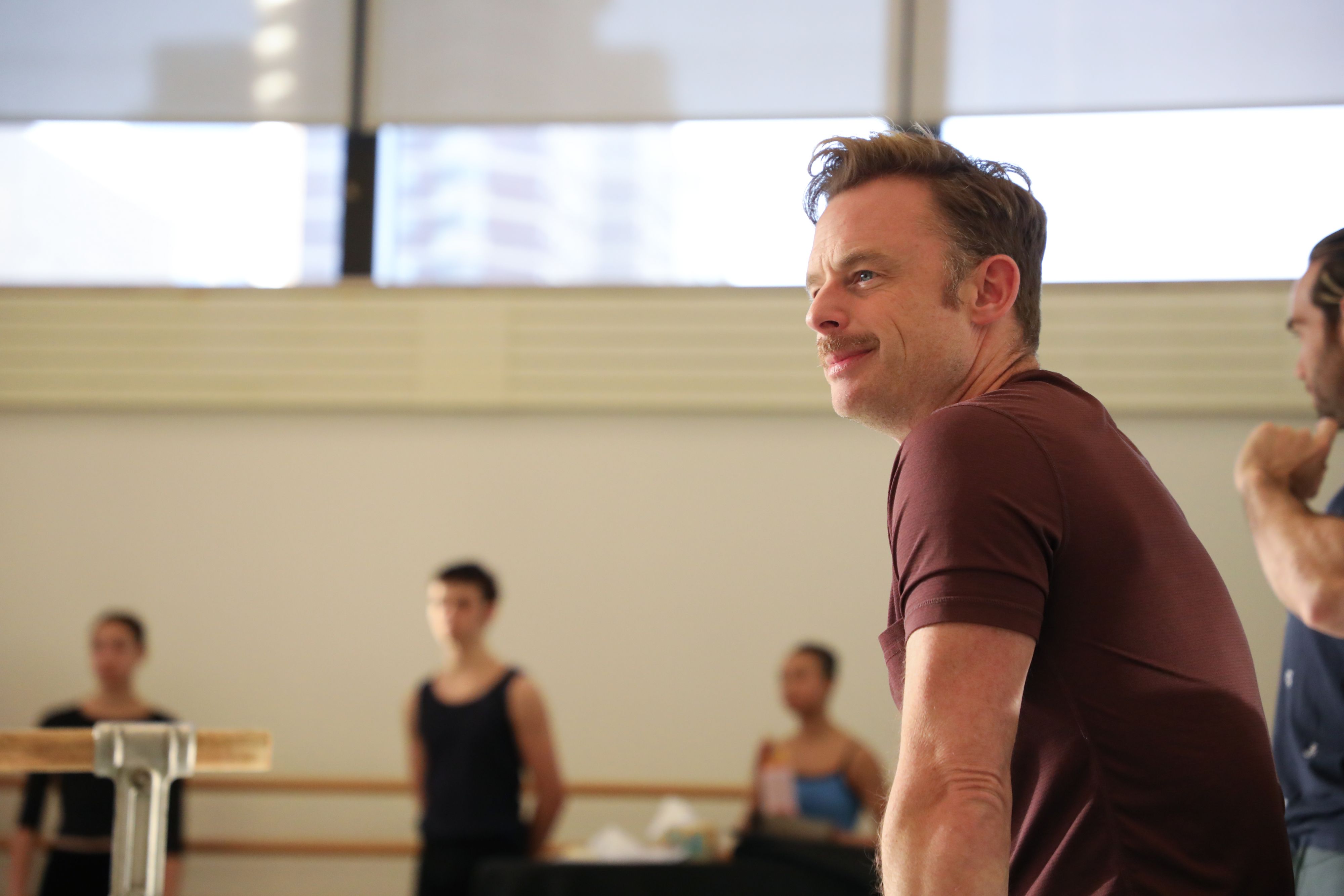 FAYE: When Craig and I got into the Company and Chris called us to Polyphonia right away—Craig was in the cast and I was one of the original understudies—it was so nice for him to be like, “These are kids, but I trust them. Come on, let's do this next thing.” Working so hard on Scènes for so many months made us particularly malleable. We were ready for new choreography, for things to be thrown at us, to say, “Okay, scrap the 16 counts that we did yesterday. Let's try this.” When you're a student, you can get very focused on the perfectionism of certain things; you can get really carried away with the shape of your hand or the line of your arabesque, for example. To understand right away that sense of shifting sands helped me in my career—knowing that everything you worked on yesterday was out the window. All ballet is like that, because every day you start over, and nothing you did yesterday really stays.
FAYE: When Craig and I got into the Company and Chris called us to Polyphonia right away—Craig was in the cast and I was one of the original understudies—it was so nice for him to be like, “These are kids, but I trust them. Come on, let's do this next thing.” Working so hard on Scènes for so many months made us particularly malleable. We were ready for new choreography, for things to be thrown at us, to say, “Okay, scrap the 16 counts that we did yesterday. Let's try this.” When you're a student, you can get very focused on the perfectionism of certain things; you can get really carried away with the shape of your hand or the line of your arabesque, for example. To understand right away that sense of shifting sands helped me in my career—knowing that everything you worked on yesterday was out the window. All ballet is like that, because every day you start over, and nothing you did yesterday really stays.
CRAIG: Dancing the pas in Scènes and Chris’s recognition of my talent as a partner led to my being in the original cast of Polyphonia; I think he wanted different stages of dancers. He had Wendy [Whelan] and Jock as the central couple, and Edwaard Liang and Jennie Somogyi were also very polished dancers. Jennifer Tinsley and Jason Fowler were a very athletic, bubbly couple, and then you have the novices—the baby couple, myself and Alexandra Ansanelli. It was definitely intimidating, especially standing in the room with Jock, who was my teacher at the School, and Wendy, who was an idol, and to see their very famous partnership night after night onstage, and then to share the stage with them. I felt that my part was very substantial, I had a purpose within the ballet. I felt as if I was treated as an equal in the studio and my voice mattered. Even as a young dancer, I was able to start to pull out my personality and feel that I had the freedom and the support to be myself and to bring something to the table. I felt very much like an individual. Chris gave each of us an opportunity to shine and to let our personalities speak.
FAYE: Scènes might be one of the ballets I'm most proud of. I hadn't watched myself do it in 20 years, but I get so excited to watch everybody else do it. We’re all part of this lineage.
CRAIG: Each generation is bringing something in that is a bit of themselves. I don't want it to be cookie cutter and I don't want them to look like me, because the world is different from what it was 25 years ago. I've no idea what it's like to be a teenager now. I want them to show us what it's like to be a dancer at that age, in this moment. And it's beautiful. They're also teaching me; there are things that they’re doing better than what I did. That's what I want. In order for this art form to continue on, it needs to keep growing and learning and to be bigger and faster and more vibrant. They're doing that.
I feel very lucky to still be around, looking at this ballet, knowing that I was part of its creation, and to still be in the house where it was created and connected to the choreographer who created it. And, still friends with my partner, Faye. I'm still close friends with a lot of the dancers from that original cast. Justin Peck was the next person who danced the role, and now I’m his assistant here at New York City Ballet, so it's all connected in a way that I think is so beautiful within this art form. I just feel really lucky and happy to get to relive it again.
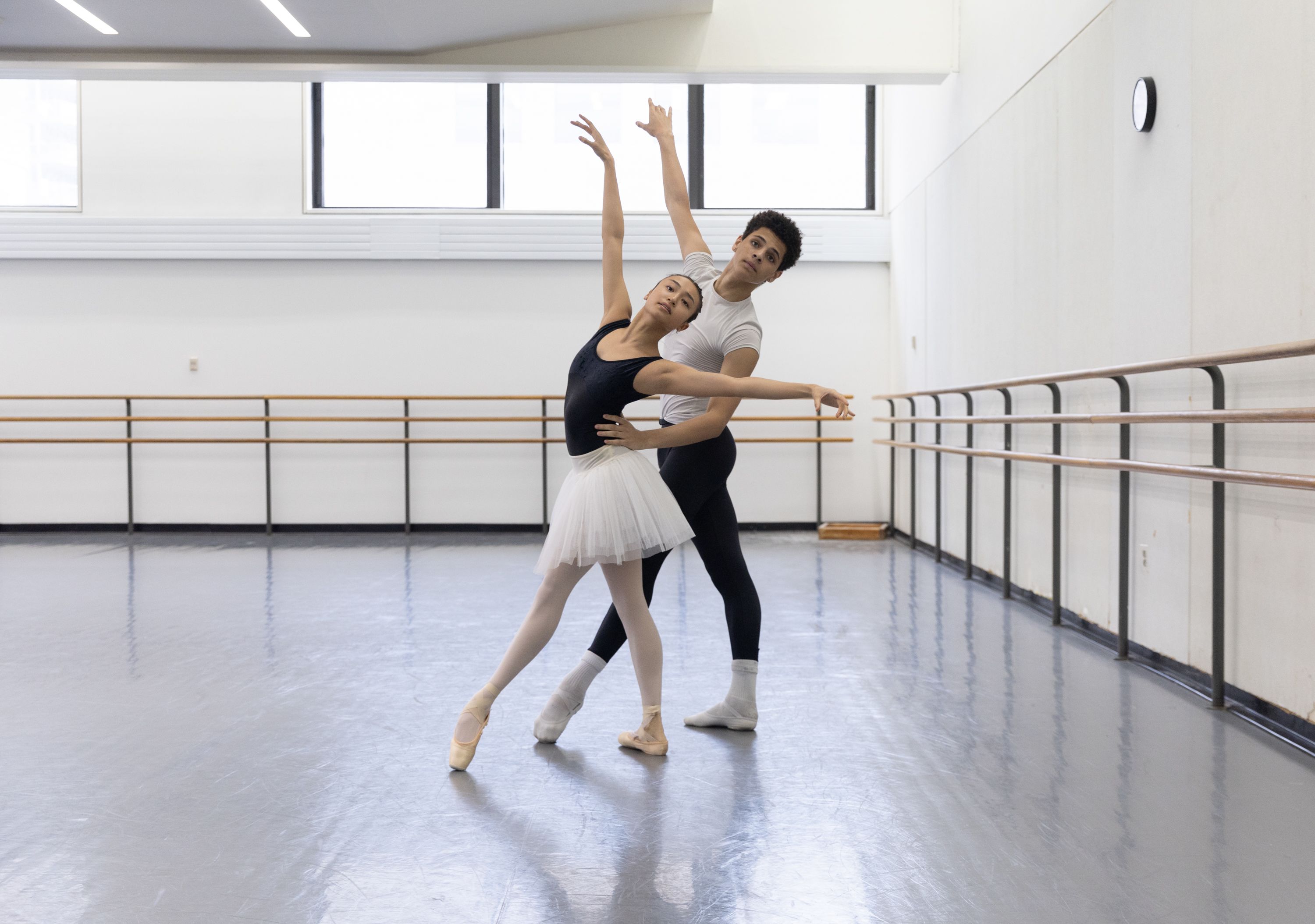 CORBIN HOLLOWAY: I'm 17—as of today, actually. I'm from Maryland, and this is my first year at SAB.
CORBIN HOLLOWAY: I'm 17—as of today, actually. I'm from Maryland, and this is my first year at SAB.
PEYTON GIN: I'm 16. I'm from New Jersey, and this is my third year at the School.
CORBIN: We had mutual friends, but we weren't very close, so this is the first chance we’ve had to actually build a relationship.
PEYTON: We first learned Scènes in October, so he'd only been here for a month.
CORBIN: I honestly didn't expect to get an opportunity like this, especially because it's my first year at the School. There are so many other boys in my class who could have done this pas, and done it very well, so I didn't really have high expectations. It was definitely a pleasant surprise.
PEYTON: I also didn't think I was going to do it because the other girls learning it were older and they were at a higher level. And, we weren't originally partnered. There was one rehearsal when Chris was here, and Corbin came up to me and said, “Gonzalo said that we should start practicing together.” And I was like, “What?!”
CORBIN: And then her partner got paired with somebody else.
PEYTON: And I was like, “I'm not doing it. They're kicking me out.”
CORBIN: And then they had us dance it together, right away, in that rehearsal. It was very scary, because we had never done it together. I had been learning it from the start, but they weren’t focusing on me. I hadn’t had that many rehearsals with Gonzalo, so it was very shaky the first time.
PEYTON: When we danced it together, Chris started reworking the choreography. So that made it a lot scarier. But I thought he made the pas fit us better with the changes that he made.
CORBIN: Ever since we got paired together, and we started doing smaller rehearsals, I feel like it's improved so much.
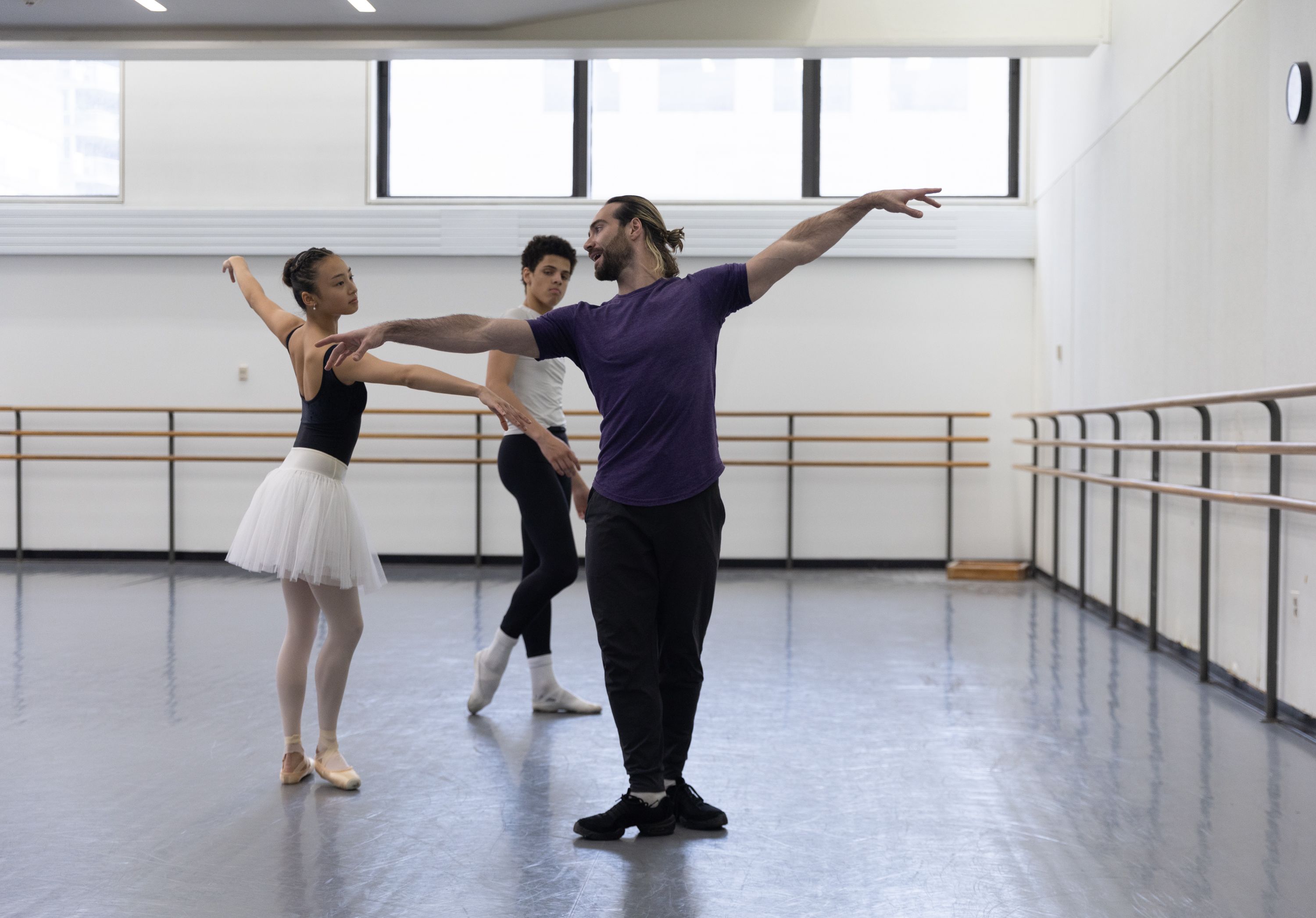 PEYTON: I think the pas de deux is a little romantic, but it's mostly about just dancing together. I'm supposed to be the little girl on the other side of the barre. She's envisioning herself when she gets older, dancing in a studio with her partner.
PEYTON: I think the pas de deux is a little romantic, but it's mostly about just dancing together. I'm supposed to be the little girl on the other side of the barre. She's envisioning herself when she gets older, dancing in a studio with her partner.
CORBIN: I'm excited to do it with costumes and lighting and an actual audience, with New York City Ballet. That's going to feel so surreal.
PEYTON: I'm nervous for the performances, but I'm excited to just get on the stage, and be in the moment. I’m also excited to dance with the kids. I know a lot of the little boys because I assist their gymnastics classes on Saturdays. It's nice to see them dancing in the studio because I usually just see them doing cartwheels.
CORBIN: Gonzalo has been so helpful for both of us. I also feel like this pas has improved my partnering and my dancing as a whole. When I first learned it, it was really hard for me and I found the littlest things so difficult. I couldn't do it. But now that we've worked on it, I feel like I've grown as a partner and as a dancer.
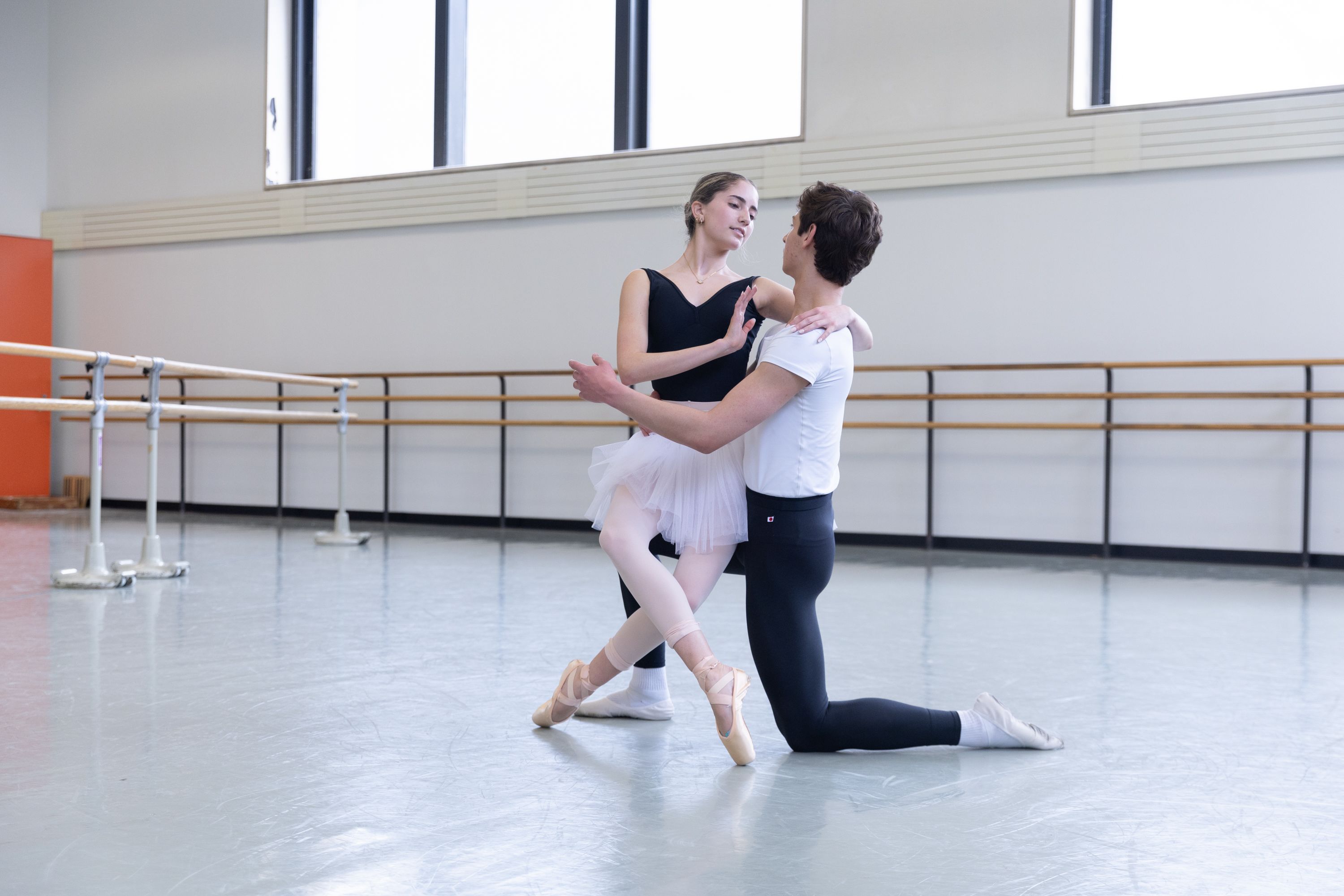 ARIEL EREZ: I'm 17. I'm from Seattle, Washington, and this is my third year at SAB.
ARIEL EREZ: I'm 17. I'm from Seattle, Washington, and this is my third year at SAB.
ALEXANDER PERONE: I'm 18 years old. I'm from New Jersey, and this is my second year at the School. I remember when we were told that we were doing Scènes de Ballet, I was so intrigued and hoped that I'd be a part of it. When we were both emailed that we would be learning the pas de deux, it was really special, because I didn't know really much about the ballet or if we’d ever have a chance to do it.
ARIEL: I used to go to Pacific Northwest Ballet School (PNB) before I came to SAB, and they performed Scènes a few years ago, so I’d heard about it. I've seen some photos of it, but I'd never seen the choreography. I heard that there was a hard pas but I didn’t really expect anything.
ALEXANDER: We were both called to the rehearsal, and we were partnered together from the beginning. This way, we got to really get to know each other and work everything out.
ARIEL: We partnered together at PNB over the summer, and we’ve partnered in some classes here. When we got partnered during the first Scènes rehearsal, I was very excited because I think we have a good connection. We work very well together.
ALEXANDER: The rehearsals have been good. Gonzalo is staging the ballet for us. He's been amazing and so knowledgeable and has set the ballet wonderfully. There's a “mirror” and a barre onstage, so we're never really facing the front, which makes the spacing very intricate. He's been helping us so much with the pas, and every time we do it, it feels like something new. It's always evolving and growing. It's never stagnant.
ARIEL: He's a very helpful teacher, because this pas is very challenging. He’ll give us a correction and it makes a step 10 times easier. Alexander and I’ve found that we need to put a lot of trust in each other. At the beginning, I had a hard time letting him lead, when I would have to do nothing.
ALEXANDER: There are times when, as the male in the role, you have to let her do the part—you can't just be a guy behind her making the steps happen. Really, it's both of us, and finding that balance was definitely a challenge. But I feel like we've gotten there.
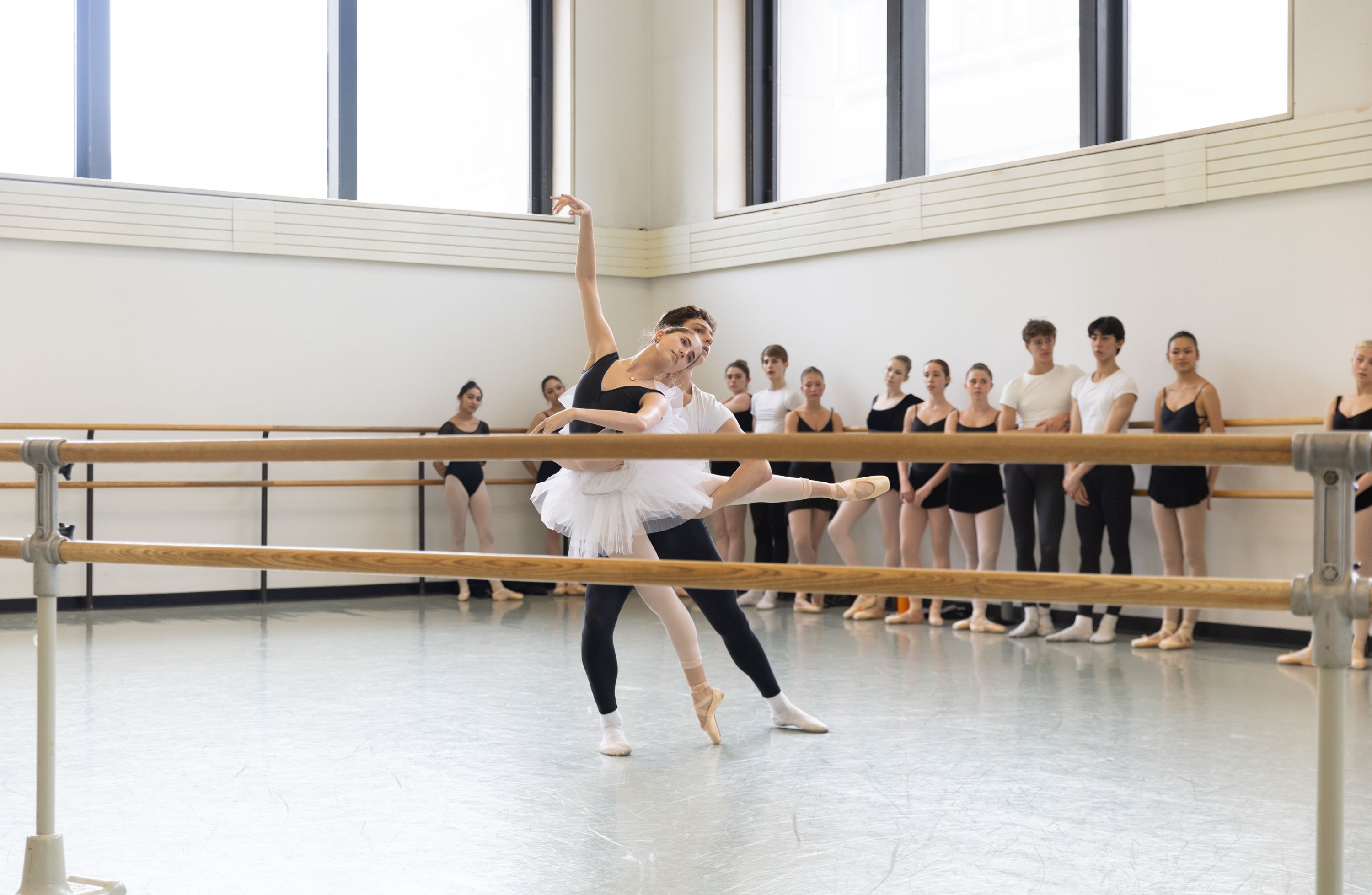 ARIEL: There are times when we have to really look at each other, and we hug. We are both trying to have a really good connection.
ARIEL: There are times when we have to really look at each other, and we hug. We are both trying to have a really good connection.
ALEXANDER: It's very romantic and youthful. It's directly reflecting who we are now, as students. A lot of the time when you're dancing, you're supposed to make yourself look like a prince or princess in some other place; you're putting on a persona. This is the opposite. We're actually reflecting who we are as humans, right now, at the School in the advanced division. It's really surreal and beautiful.
ARIEL: The very first time we come up on stage right, we come on in this big lift where Alexander is lifting me onto the stage, so I’m kind of floating. I'm going to be very excited to see the lights and the audience.
ALEXANDER: It feels like a true blessing to do something like this—to be at the School at this time in the world is really like something we should be grateful for. This opportunity to perform in the Koch Theater with New York City Ballet during spring performances, not every student gets to do that. We're just very grateful.
ARIEL: And also just to do it with each other—with a partner who we trust and are having fun with.
Performance photos of Faye Arthurs and Craig Hall and SAB students © Paul Kolnik. Studio photos of Christopher Wheeldon with SAB students by Heather Toner © New York City Ballet. Studio photos of Peyton Gin, Corbin Holloway, Ariel Erez, and Alexander Perone and Repertory Director Gonzalo Garcia © Rosalie O'Connor.



